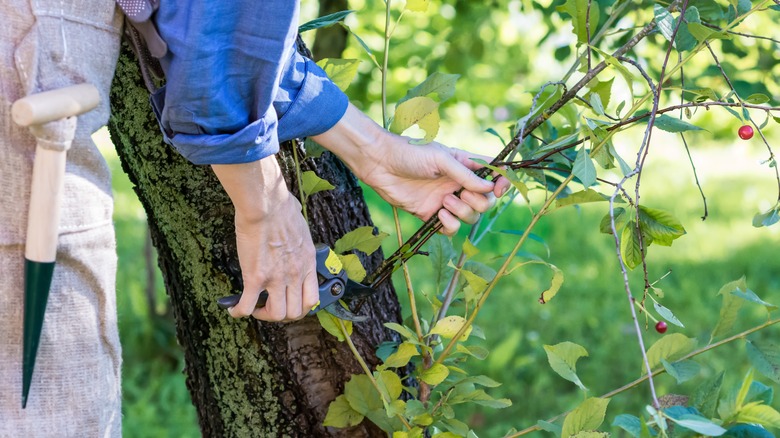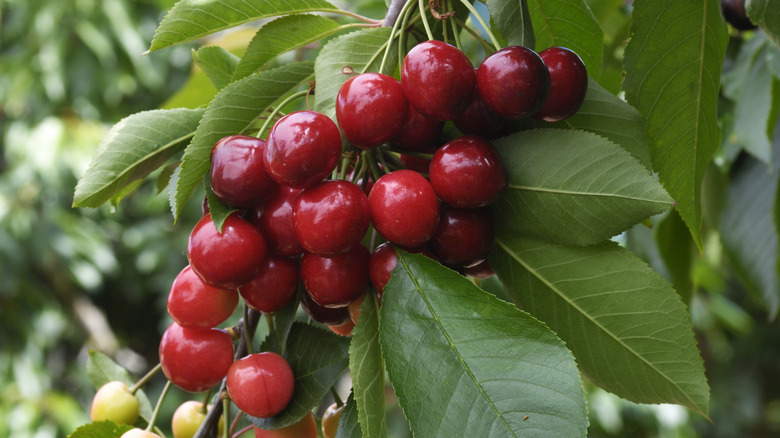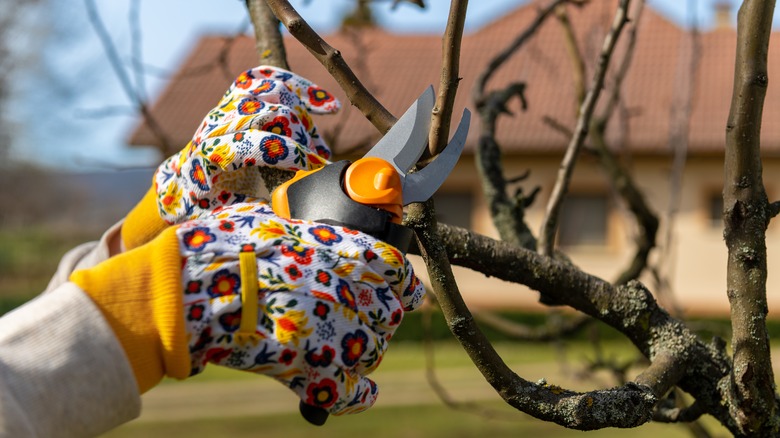The Best Time Of Year To Prune Your Cherry Tree, And How To Do It
If you're the proud owner of a cherry tree, you might be aware by now that proper pruning not only maintains the health of your cherry tree but also optimizes its fruit production and structural integrity. Knowing when to prune is crucial. Generally, the best times to prune a cherry tree are in the late summer or during the spring. This timing is vital because pruning should occur after the tree has commenced its growth cycle in the spring. Pruning during the tree's dormant phase, typically in the winter, can leave it vulnerable to diseases and infections. In spring, the cherry tree starts to awaken from its dormancy, and new growth becomes evident. Pruning at this stage allows you to train the tree as it grows. It also minimizes stress, as the tree is actively growing and can recover more efficiently from pruning. On the other hand, thinning cuts are best done in late summer pruning. Late summer pruning also helps in removing any growth that might be undesirable or unproductive. The timing ensures that the cuts have enough time to heal before the onset of winter, reducing the risk of disease.
Understanding the right time for pruning is just the first step. The process itself is an art that requires knowledge of why, how, and where to prune your trees. It also helps to understand the nuances of pruning and how it impacts health and fruit production.
Why pruning is important for cherry trees
Pruning is not just about cutting away unwanted branches; it's a vital practice for the health and productivity of your cherry tree. The primary reasons for pruning include stimulation, survival, and maintaining shape and structure. First, pruning stimulates new growth. By selectively removing parts of the tree, you encourage the development of new, healthy branches and leaves. This new growth is essential for a cherry tree to produce abundant and quality fruit. Pruning also removes dead or diseased wood, which can hinder the tree's overall health and fruit production.
Second, pruning is crucial for the tree's survival. Overgrown or densely packed branches can lead to poor air circulation. This environment is conducive to the development of diseases and pests. By pruning, you open up the tree's structure, allowing for better airflow and sunlight exposure, which reduces disease risk and promotes healthy growth. Lastly, pruning helps maintain the cherry tree's shape and structure. A well-pruned cherry tree has a balanced, aesthetically pleasing shape that supports fruit production. It also ensures that the tree's branches are strong enough to bear the weight of the fruit without breaking, which is crucial for both the tree's health and the safety of its surroundings.
How to prune cherry trees
Pruning a cherry tree, especially in its formative years, is essential for establishing a strong structure and ensuring fruitful harvests. The process varies slightly over the first three years. In the first year, focus on establishing a strong leader (the main upward-growing branch) and select several scaffold branches. Scaffold branches are the primary limbs that grow outwards from the trunk and form the tree's main structure. Choose 3-5 strong branches that are properly spaced and evenly distributed around the trunk. These will become the main fruit-bearing branches as the tree matures.
During the second and third years, continue to develop the tree's structure. Remove any competing branches that threaten the dominance of the central leader. Also, prune away any inward-growing branches to maintain an open canopy for better light and air circulation. It's important to balance the tree's growth, ensuring that the scaffold branches develop symmetrically and the tree doesn't become lopsided.
As the cherry tree matures, annual pruning involves removing twigs as well as any dead or diseased wood. You might also need to remove a couple of low-hanging branches. Always make your cuts at a 45-degree angle just above a bud or branch to encourage healthy regrowth. Safety is paramount when pruning. Ensure you use sharp and effective pruning shears to make clean cuts and reduce the risk of disease. Also, be mindful of your safety when using ladders or climbing the tree.


